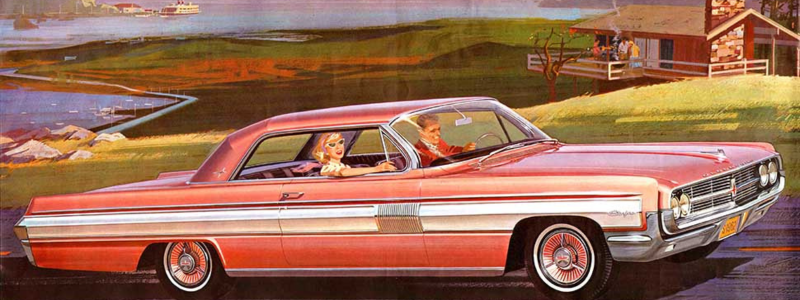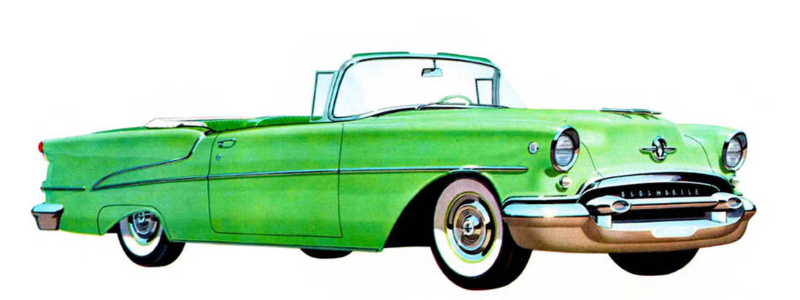General Year Information
Many appearance improvements marked the 1954 Cadillacs. They included a lower, sleeker body, a new cellular grille insert, inverted gull-wing front bumpers, and tapered “Dagmar” style bumper guards.
An Eldorado-type wraparound windshield was seen on all models. Sedans used a distinctive type of window reveal molding which created a built-in sun visor effect. For coupes, a smoothly curved wraparound backlight was referred to as the ‘Florentine’ style rear window. A wide ventilator intake now stretched across the base of the windshield on all models, and the chrome-visored headlamp look was emphasized.
INNOVATIONS: A 12-volt electrical system and aluminum alloy pistons were standard equipment for Cadillac in 1954.
HISTORICAL BACKGROUND: Assembly of 1954 models began January 4, 1954 after a 25-day halt for changeover to new production specifications. Fiberglass-bodied Cadillac show cars appearing at the GM Motorama this year included the Park Avenue four-door sedan, El Camino coupe, and La Espada convertible.
1954 Production was 96,680, down from 109,119 in 1953. (See 1954 the Production Figures Chart for detailed information).
Chassis Information
- Wheelbase: Series 62 129.0″, Series 60S 133.0″, Series 75 149.8″ The commercial Series 75 chassis utilized a 158″ wheelbase. This was provided for construction of funeral cars, ambulances, etc.
- Overall length: Series 62 Sedan 216.4″, All other Series 62 223.4″ Series 60S 227.4″, Series 75 231.7″
- Front tread: All – 60.0″. Rear tread: All – 63.1″.
- Standard tires: Series 75 8.20 x 15, Eldorado 8.20 x 15 whitewalls, All Others 8.00 x 15.
- Optional tires: Series 60 and 62, except 6267S 8.20 x 15 whitewall.
Models Offered
Series 62 Included – 4-door sedan, export sedan, Sedan DeVille, 2-door hardtop coupe, Coupe deVille, and Convertible. The Eldorado convertible was part of series 62 by chassis, but considered a separate model.
The Series 62 chassis had a brand new, longer wheelbase of 129 inches. The 62 Series cars did not have rear fender louvers. V-shaped ornaments and Cadillac crests were used on the hood and the rear deck, and there were full-length body lower edge sill molding trim in bright metal. “Coupe DeVille” in script was placed on the rear corner pillars of the luxury hardtop, which also had even wider sill moldings.
The Eldorado convertible (model 6267SX) had gold crests centered directly behind the air-slot rear fender breaks and wide, fluted, lower rear body beauty panels, which were made of extruded aluminum. They also appeared on a unique, one-of-a-kind Eldorado coupe built for the president of the Reynolds Aluminum Company. The production Eldorado convertible had monogram plates on the doors, wire wheels, and custom interior trim with the Cadillac crest embossed on the seat bolsters. Another one-off creation was an exclusive Sedan DeVille.
Automatic windshield washers, power steering, 12-volt electrical system, and aluminum alloy pistons made the long standard equipment list this year. The Series 62 four-door sedan was now seven inches shorter than other models in this range.
The Series 60 was essentially a Series 62 with the wheelbase stretch from 129 to 133 inches. All other identification and standard features were the same as the Series 62.
The big Fleetwood “high headroom” sedan came as an eight-passenger limousine with driver’s partition or eight-passenger sedan without; however, both had “jump seats”. V-shaped ornaments appeared on the hood and rear deck with “Fleetwood” in script on the rear deck. Wheelbase increased to 149.8 inches. Styling changes were the same as on other lines.
Engines
- Overhead valves. Cast Iron Block. Displacement: 331 CID. Bore and stroke: 3.8125″ x 3.625″. Compression ratio: 8.25:1. Horsepower: 230 @ 4400 RPM. Torque: 330 @ 2700 RPM. Five main bearings. Hydraulic valve lifters. Camshaft Duration: Intake 269°, Exhaust 270°, Overlap Unk°, Lift (Intake) 0.365″ (Exhaust) 0.365″. Carburetors: Carter WCFB four-barrel Model 2109S. also fitted: Rochester 4GC four-barrel (with Air Cond.) Model 7006963; (without Air) Model 7006962.
Engine Options and Availability
- There were no options in this year.
Power Train Options
- Hydra-Matic automatic transmission was standard except on Series 75 where a GM 3-speed manual was standard.
- Dual exhaust system standard.
- Rear axle ratios: Standard 3.07:1, Optional without air conditioning 3.36:1, Standard with air conditioning 3.36:1.
Body Paint Color Codes
Other Significant Options
- Air-conditioning ($620).
- Autronic Eye automatic headlamp dimmer.
- Chrome wire wheels ($325).
- E-Z-Eye tinted glass.
- Heater ($129).
- Horizontal front seat adjuster (standard on Coupe DeVille, convertible, Eldorado, Series 60S and Series 75).
- Hydra-Matic drive on Series 75 ($186).
- Power brakes ($48).
- Power operated window and seat ($124).
- Radio ($120).
- Vertical front seat adjuster.
- White sidewall tires ($49 exchange).











